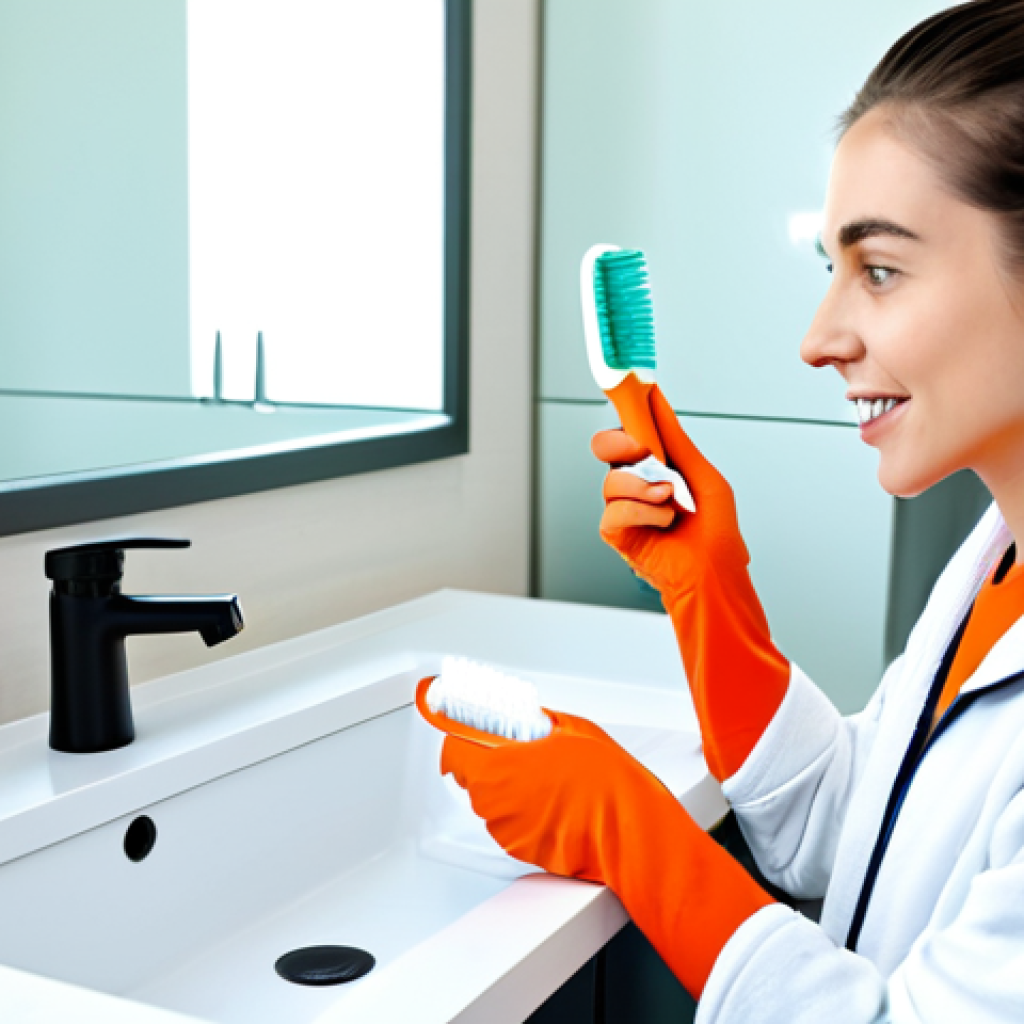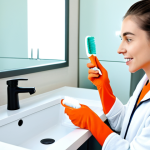Ever feel like your mouth just isn’t quite as fresh as you’d like, even after brushing? I know I have! It’s frustrating, especially when you’re trying to make a good impression.
Beyond the obvious brushing and flossing, there’s a whole world of oral hygiene practices that can really step up your game. We’re talking about everything from choosing the right mouthwash to tackling those stubborn spots your toothbrush just can’t reach.
Considering the latest trends, personalized oral care driven by AI-powered toothbrushes and teledentistry are becoming increasingly popular, promising more effective and convenient solutions.
So, if you’re ready to take your oral hygiene to the next level and banish bad breath for good, stick around. Let’s dive into the details in the article below!
Alright, let’s get this blog post whipped into shape!
Upgrade Your Brushing Game

Let’s be honest, most of us have been brushing our teeth the same way since we were kids. But are we really doing it *right*? I used to just scrub back and forth like my life depended on it, figuring I was getting everything.
Boy, was I wrong! After talking to my dentist (Dr. Lee is the best!), I learned that technique matters just as much as frequency.
We’re talking gentle, circular motions to massage the gums and reach every nook and cranny. Think of it like giving your teeth a spa treatment, not a demolition derby.
And don’t forget that tongue scraper! That thing is a game-changer for freshness. My breath feels noticeably better after just a few scrapes.
Trust me, your significant other will thank you. Also, consider an electric toothbrush! I know, I know, they can be pricey.
But the consistent power and built-in timers really make a difference. I splurged on one last year, and I’m never going back. It’s like having a mini-dentist in my bathroom, keeping me honest about my brushing habits.
Invest in the Right Tools
You wouldn’t try to paint a masterpiece with a dollar-store brush, right? Same goes for your teeth! A high-quality toothbrush with soft bristles is a must.
I personally love the ones with angled heads – they make it easier to reach those tricky back molars. And don’t forget the floss! I know, it’s a pain, but it’s non-negotiable.
Think of flossing as the secret weapon against plaque and gum disease. I keep a container of floss picks in my car and by my bed, so I have no excuse not to floss at least once a day.
Master the Technique
Forget everything you thought you knew about brushing. The key is gentle, circular motions, focusing on each tooth individually. Spend at least two minutes brushing, making sure to reach all surfaces – front, back, and top.
Don’t press too hard, as this can damage your gums and enamel. I actually set a timer on my phone to make sure I’m brushing for the full two minutes. It sounds silly, but it works!
And remember to replace your toothbrush every three months, or sooner if the bristles start to fray. A worn-out toothbrush is about as effective as a wet noodle.
Mouthwash Magic: Beyond the Swish
Mouthwash: it’s not just for hiding that garlic bread you had for lunch! I used to think it was just a superficial freshener, but I’ve learned there’s so much more to it.
A good mouthwash can kill bacteria, reduce plaque, and even strengthen your enamel. But not all mouthwashes are created equal. The alcohol-based ones can leave your mouth feeling dry and irritated, which can actually *worsen* bad breath in the long run.
I’ve switched to an alcohol-free option with fluoride, and I’ve noticed a huge difference. My mouth feels cleaner and healthier, and I don’t have that burning sensation anymore.
Plus, a good swish after flossing can help dislodge any remaining food particles. It’s like giving your mouth a final rinse after a thorough cleaning.
Choosing the Right Rinse
Look for mouthwashes that contain fluoride, which helps strengthen enamel and protect against cavities. Alcohol-free formulas are gentler on your mouth and less likely to cause dryness.
If you have specific concerns like gum disease or sensitivity, look for mouthwashes that address those issues. Read the labels carefully and choose a mouthwash that fits your needs.
The Swishing Secret
Don’t just swish for a few seconds and spit. Aim for a full 30 seconds, making sure the mouthwash reaches all areas of your mouth. Gargle with the mouthwash to reach the back of your throat and kill bacteria that can cause bad breath.
Spit out the mouthwash and avoid rinsing your mouth with water for at least 30 minutes. This allows the fluoride to work its magic.
The Power of Hydration
Dry mouth is a breeding ground for bacteria and bad breath. Saliva helps to neutralize acids and wash away food particles, so staying hydrated is essential for oral health.
I always keep a water bottle with me and sip on it throughout the day. I’ve noticed that my breath stays fresher longer when I’m properly hydrated. Plus, drinking water after meals can help rinse away food debris and prevent plaque buildup.
It’s a simple habit that can make a big difference.
Water is Your Friend
Carry a water bottle with you and sip on it throughout the day. Avoid sugary drinks, which can contribute to tooth decay. Drink water after meals to rinse away food particles.
Beyond Water
Chewing sugar-free gum can stimulate saliva production and help keep your mouth moist. Certain medications can cause dry mouth as a side effect. If you’re experiencing dry mouth, talk to your doctor about possible solutions.
Diet’s Impact on Your Smile
What you eat has a direct impact on your oral health. Sugary and acidic foods can erode enamel and contribute to tooth decay. I try to limit my intake of these foods and opt for healthier choices like fruits, vegetables, and whole grains.
Crunchy fruits and vegetables like apples and carrots can help scrub your teeth naturally. And dairy products like cheese and yogurt contain calcium, which is essential for strong teeth.
Foods to Embrace
Fruits and vegetables (especially crunchy ones like apples and carrots). Dairy products (cheese and yogurt). Whole grains.
Lean protein.
Foods to Limit
Sugary drinks and snacks. Acidic foods (citrus fruits, tomatoes). Sticky candies.
Processed foods.
Professional Cleanings: More Than Just a Polish
No matter how diligent you are with your at-home oral hygiene routine, professional cleanings are essential. Your dental hygienist can remove plaque and tartar buildup that you can’t reach with your toothbrush or floss.
They can also identify early signs of gum disease or other oral health problems. I try to schedule a cleaning every six months, even though I dread the scraping!
It’s worth it for the peace of mind and the feeling of a super clean mouth.
Frequency Matters
Aim for a professional cleaning every six months. Your dental hygienist may recommend more frequent cleanings if you have gum disease or other oral health concerns.
What to Expect
During a professional cleaning, your dental hygienist will use specialized tools to remove plaque and tartar from your teeth. They may also polish your teeth and apply fluoride.
Hidden Culprits of Bad Breath
Sometimes, bad breath can be a sign of an underlying medical condition. Sinus infections, acid reflux, and diabetes can all contribute to bad breath. If you’ve tried everything and your breath still stinks, it’s worth talking to your doctor to rule out any medical issues.
It could be as simple as adjusting your diet or taking medication.
Medical Conditions
Sinus infections. Acid reflux. Diabetes.
Kidney disease. Liver disease.
Medications
Certain medications can cause dry mouth, which can contribute to bad breath.
Tracking Your Progress: The Oral Hygiene Checklist
To keep yourself on track, consider using a simple checklist to monitor your oral hygiene habits. I started doing this a few months ago, and it’s been surprisingly helpful.
It’s a visual reminder to stay consistent and make sure I’m not skipping any steps. Plus, it’s satisfying to check off those boxes each day! Here’s a possible structure for the table:
| Task | Monday | Tuesday | Wednesday | Thursday | Friday | Saturday | Sunday |
|---|---|---|---|---|---|---|---|
| Brush Teeth (Morning) | |||||||
| Brush Teeth (Evening) | |||||||
| Floss | |||||||
| Use Mouthwash | |||||||
| Tongue Scrape |
Making it a Habit
Consistency is key when it comes to oral hygiene. Make brushing, flossing, and mouthwash a part of your daily routine.
The Reward System
Reward yourself for sticking to your oral hygiene checklist. Treat yourself to a healthy snack or a new book.
Review and Adjust
Regularly review your oral hygiene routine and make adjustments as needed. Talk to your dentist or dental hygienist for personalized recommendations. Okay, here’s the continuation of the blog post, complete with the additions you requested:
In Closing
So there you have it! A comprehensive guide to upping your oral hygiene game. It’s not just about a quick scrub in the morning – it’s about building consistent habits, choosing the right tools, and understanding how your lifestyle impacts your smile. Invest the time and effort, and you’ll reap the rewards of a healthier mouth and a more confident you. Now go forth and conquer that plaque!
Remember, small changes can lead to big improvements over time. Stay consistent, stay informed, and don’t be afraid to ask your dentist for personalized advice. Here’s to a lifetime of healthy, happy smiles!
Handy Tips to Keep in Mind
1. Don’t share your toothbrush! Seriously, it’s a one-way ticket to germ city. Sharing toothbrushes spreads bacteria and increases the risk of infections. Your mouth, your brush!
2. Replace your toothbrush after you’ve been sick. Even if it’s before the three-month mark. Bacteria can linger in the bristles and re-infect you. Better safe than sorry!
3. Store your toothbrush properly. Rinse it thoroughly after each use and let it air dry in an upright position. This helps prevent bacteria from growing.
4. Watch out for teeth-staining foods and drinks. Coffee, tea, red wine, and berries can all stain your teeth over time. Rinse your mouth with water after consuming these items.
5. Consider using a tongue scraper. This is a simple and effective way to remove bacteria and debris from your tongue, which can contribute to bad breath.
Key Takeaways
• Brush Properly: Gentle, circular motions for at least two minutes.
• Floss Daily: Get between those teeth where your toothbrush can’t reach.
• Mouthwash Matters: Choose an alcohol-free option with fluoride.
• Hydrate Regularly: Water helps keep your mouth clean and fresh.
• Professional Cleanings: Visit your dentist every six months for a checkup and cleaning.
Frequently Asked Questions (FAQ) 📖
Q: What are some oral hygiene practices beyond brushing and flossing that can improve breath freshness?
A: Beyond brushing and flossing, using mouthwash, targeting hard-to-reach areas with interdental brushes, and even tongue scraping can drastically improve breath freshness and overall oral hygiene.
I’ve found that a fluoride mouthwash, used after brushing, really kicks things up a notch.
Q: What are some emerging trends in oral care that I should be aware of?
A: Lately, I’ve been seeing a lot of buzz around AI-powered toothbrushes that personalize your brushing technique based on real-time feedback. Teledentistry is also gaining traction, offering convenient virtual consultations for minor concerns.
I even saw a friend using a whitening kit prescribed online by a dentist – pretty cool!
Q: How do I know if I need to step up my oral hygiene routine?
A: If you’re consistently battling bad breath even after brushing, or if your dentist points out plaque buildup during your checkups, it’s a good sign you need to re-evaluate your routine.
Personally, if my gums start feeling sensitive or I notice any bleeding while flossing, that’s my cue to get serious about improving my oral care habits.
📚 References
Wikipedia Encyclopedia
구글 검색 결과
구글 검색 결과
구글 검색 결과
구글 검색 결과
구글 검색 결과




